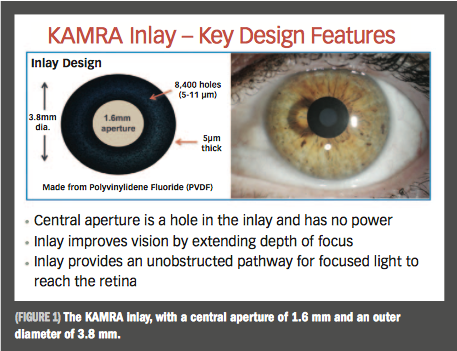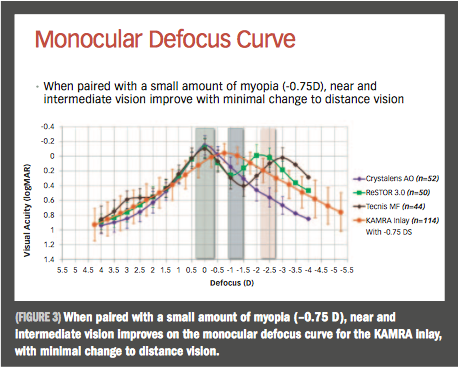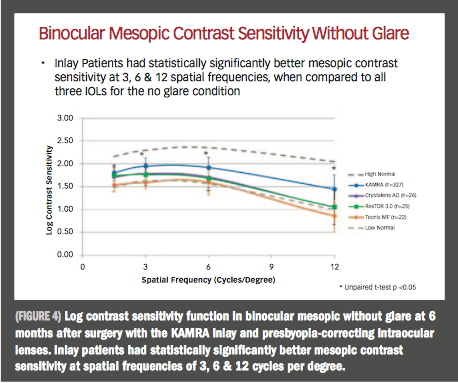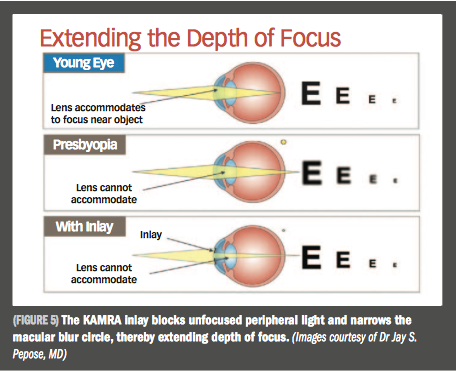Article
Presbyopia therapy: Comparison of corneal versus lens-based options
The authors assess the quantitative and qualitative aspects of vision following various lens- and corneal-based therapies for presbyopia. In many cases the KAMRA corneal inlay offers a long-term solution. It can easily be removed if the patient is not satisfied with the outcome.
Take-home: The authors assess the quantitative and qualitative aspects of vision following various lens- and corneal-based therapies for presbyopia. In many cases the KAMRA corneal inlay offers a long-term solution. It can easily be removed if the patient is not satisfied with the outcome.
At some point, everybody aged over 40 will experience the effect of the progressive loss of accommodation as the crystalline lens loses its ability to increase its dioptric power at near vergence, a condition known as presbyopia. Globally, presbyopia is projected to increase to 1.4 billion by 2020 and to 1.8 billion by 2050; 1 it represents the most common human ocular affliction.
In our technology-reliant world, any vision deficit at intermediate or near affects quality of life and can hinder daily activities critical to both professional and personal tasks. Increasingly, patients elect to have refractive procedures performed independently, or concurrently with cataract removal or clear crystalline lens replacement, in an effort to decrease or eliminate their dependence on reading glasses or bifocals. To meet this growing demand and satiate rising consumer expectations for corrective vision surgery, industry is responding with new corneal and lens-based surgical innovations, including small-aperture corneal inlays and accommodating and multifocal intraocular lens implants. We performed a study to assess the quantitative and qualitative aspects of vision at different vergences with these lens- and corneal-based options.
Related: Was 2015 the year of inlays, FLACS, or something else?
Small-aperture optics

Small-aperture optics is predicated on the same concept as adjusting the aperture of a camera, whereby increasing the f-stop (i.e., creating a smaller aperture) enhances depth of focus. The KAMRA intracorneal inlay (AcuFocus, Irvine, California, USA) is similarly designed to increase depth of focus by blocking unfocused peripheral light rays, thereby reducing the size of the macular blur circle. The inlay is made from polyvinylidene difluoride and has an inside aperture of 1.6 mm and an outside diameter of 3.8 mm. It is 6 microns thick and is fenestrated with 8400 holes in a pseudorandom pattern to facilitate the exchange of glucose and other metabolites (Figure 1). It is implanted in a corneal pocket with a depth of at least 200 microns, created using a femtosecond laser. The result of small-aperture optics is an extended range of continuous vision spanning near, intermediate and far (Figure 2). This differs from the mechanism of action of multifocal and accommodating IOL designs that address presbyopia following cataract or clear lens extraction. Current accommodating IOLs, such as Crystalens Advanced Optics (AO; Bausch + Lomb Surgical, Aliso Viejo, California, USA), produce excellent distance and intermediate vision but are limited and variable in their range of accommodation and generally do not produce as good a monocular near visual acuity as multifocal lens designs. Multifocal IOLs distribute light among multiple energy foci for near and far distances, thereby improving near visual acuity over the standard monofocal IOL. However, there are several inherent potential disadvantages to multifocal IOLs, including reduced contrast sensitivity, degraded image quality and photic visual symptoms such as glare/haloes. 2
Small-aperture inlay vs presbyopia-correcting IOLS
Small-aperture inlay vs presbyopia-correcting IOLs

When determining the optimal surgical solution for patients, visual demands, expectations, environment, current level of crystalline lens dysfunction and other ocular characteristics must be considered. Regardless of the choice, all involve some compromise.
To assess the performance of specific presbyopia-correcting IOLs and the small-aperture inlay, we conducted a study to compare monocular and binocular mesopic contrast sensitivity and through focus following monocular implantation with a KAMRA small-aperture inlay or binocular implantation with an accommodating or multifocal IOL implant.
Practice Management: 5 strategies to grow your practice
Data were drawn from a study population of 507 emmetropic subjects with KAMRA inlays; predetermined subgroups included 327 subjects who underwent contrast sensitivity testing and another 114 subjects for defocus curve testing, along with 78 subjects randomised between bilateral Crystalens AO, AcrySof IQ ReSTOR D3.0 D (Alcon Laboratories, Fort Worth, Texas, USA) or Tecnis 4D Multifocal (Abbott Medical Optics, Santa Ana, California, USA) IOL. Our findings follow:
Inlay patients had statistically significantly better binocular mesopic contrast sensitivity compared with all three IOLs at spatial frequencies of 3, 6 and 12 cycles per degree for the no-glare condition and at all spatial frequencies tested with glare.
Patients implanted monocularly with the KAMRA small-aperture inlay, without correction, achieved better mesopic contrast sensitivity with and without glare at selected spatial frequencies than patients implanted with either accommodating or multifocal IOLs with correction.
Defocus curve results show that the small-aperture inlay provides the broadest continuous range of functional vision (20/40 or better).
Pairing a small amount of myopia (–0.75D) with the small-aperture inlay significantly improves near and intermediate performance as well as or better than the three IOLs (Figure 3).

The multifocal IOLs produced better near vision at 40 cm, but this was at the cost of significantly reduced contrast and increased scatter.
The small-aperture inlay performed better at intermediate vision than all three IOLs, when all were compared with distance correction.
In summary, the KAMRA inlay subjects demonstrated improved intermediate and near vision with minimal to no change to distance vision, better contrast sensitivity in the inlay eye when compared with the multifocals and better binocular contrast sensitivity when compared with all three IOLs (Figure 4). Crystalens AO was superior in uncorrected intermediate vision compared with the KAMRA inlay, but not in distance-corrected intermediate; it was worse in near vision. The multifocals were superior in near vision at their respective optimum near focus points, but worse in intermediate vision, compared with both KAMRA inlay and Crystalens AO. 3
KAMRA small aperture inlay vs monovision
KAMRA small aperture inlay vs monovision
Monocular implantation of the KAMRA inlay is not equivalent to monovision. The KAMRA inlay blocks unfocused peripheral light and narrows the macular blur circle, thereby extending depth of focus (Figure 5). Placed in only the non-dominant eye, the improvement in near and intermediate vision does not come at the cost of distance vision, which generally remains within one line of preoperative vision. The dominant eye remains untouched or can be brought to distance with LASIK in the case

of ametropia. With both eyes working in summation, the patient has a full range of vision. Conversely, monovision corrects one eye (via contact lenses, LASIK or pseudophakia) for near and the other for distance vision. Monovision, with sufficient offset between the two eyes to improve near vision to a clinically meaningful degree, degrades far vision in the monovision eye and also reduces stereopsis.
Small-aperture monocular treatment offers several advantages over monovision. First, because the small aperture achieves better near vision by blocking unfocused light rather than by changing the refractive power of the eye, the effect is relatively immune to the progressive loss of accommodation. Second, postoperative stereopsis in KAMRA patients has been demonstrated to be not statistically different from preoperative stereopsis. 4
Third, if the dominant eye is corrected for distance but does not achieve at least 20/25, or if distance vision deteriorates over time, the patient will not have good distance vision in either eye, whereas both eyes see distance with the KAMRA inlay.
Finally, the inlay can easily be removed if the patient is not satisfied with the outcome.
Slideshow: How will ophthalmology will evolve in 2016?
Conclusion

Patients considering surgical correction of presbyopia have multiple options available. Both the patient and surgeon must carefully consider not only the demonstrated performance of these devices, but the patients’ visual requirements and expectations, and the degree of existing crystalline lens dysfunction. For the appropriate surgical candidate, this KAMRA corneal inlay offers a long-term solution for presbyopia, with demonstrated outcomes and long-term safety features.
References
B.A. Holden et al ., Arch. Ophthalmol. 2008; 126(12): 1731-1739.
J.A. Davison and M.J. Simpson. J. Cataract Refract. Surg. 2006; 32(5): 849-858.
S. Vilupuru, L. Lin and J.S. Pepose. Am. J. Ophthalmol. 2015; 160(1): 150-162.
R.L. Lindstrom et al., Curr. Opinion Ophthalmol. 2013; 24(4): 281-287.
Dr. Jay S. Pepose, PhD
Dr. Jay S. Pepose, MD, PhD, is the founder and medical director of the Pepose Vision Institute in St Louis, Missouri, USA, and also serves as Professor of Clinical Ophthalmology at Washington University School of Medicine, St Louis, Missouri, USA. Dr Pepose is the author of over 200 peer-reviewed publications on laser vision correction, multifocal and accommodating intraocular lens implants and new treatments for presbyopia.
Dr Pepose is a consultant to Acufocus, Abbott Medical Optics and Bausch + Lomb
Newsletter
Don’t miss out—get Ophthalmology Times updates on the latest clinical advancements and expert interviews, straight to your inbox.





